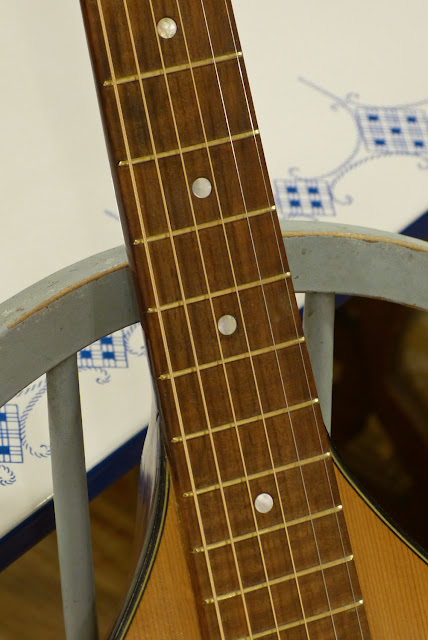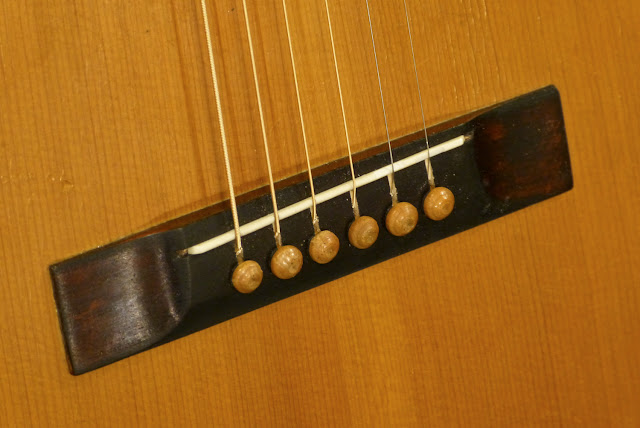1943 Levin Model 122 Steel String Guitar-Lute
I worked on a 1945 Model 127 flat-backed Levin lute guitar back in 2010 so I sort-of knew what to expect when this came to the workshop a long while ago. I let it sit, neglected, for a long time and then finally finished it off for its owner a couple days ago. It's been raining and snowing and so I decided enough was enough and took some shots this evening in the shop.
Compared to that 127, this curved-back instrument (closer to a real lute's shape) has a bit more focus and cleaner sustain but less warmth. It's thus not a delicious-sounding instrument with a flatpick but it's exceedingly pretty-sounding fingerpicked. I gather this was the intention because the design of it certainly screams "parlor folk music" to me. This one has a 143346 serial number which places it at 1943 and I can just imagine this getting use as an escapist's solution during those years. I pegged the model number via the highly-useful Vintage Levin Info site as well.
Most lute-shaped guitars (I'm talking about the ever-familiar Germanic examples from the 1890s through the 1970s) are intended for gut/nylon strings, but the Levin lute-style guitars from the 30s and on up tend to be made for steel (as evidenced by the taller, bulkier ladder bracing and compensated saddle slot). This makes them somewhat interesting as far as this minority world of the guitar market goes.
The materials are typical for Levin guitars of the time -- everything is solid -- with a spruce top, flamed birch back and sides, maple neck and bridge, and a figured walnut fretboard. The frets are brass, the nut and saddle are some sort of plastic (celluloid, perhaps?), and everything is original save the strap button (which was damaged).
As usual, the Levin build is first-rate, lightweight, and pays close attention to detail in terms of the cut of all the components (braces, neck joint, etc.), which made it worth the effort to repair it. Aside from the back repairs in that link, I also gave it a fret level/dress, shaved/vintaged the bridge, and gave it a good setup.
It's strung with 50w-11 at the moment (though 46w-10 might be a better bet long-term), has a 24 3/4" scale length, and a medium-sized, C-shape neck profile. It's a bit chunky but perfectly useful for folksy music. I wouldn't want to be trying to do any acrobatics on this neck, though. The neck itself is also pretty stable but it does deflect just a hair under tension.
Who doesn't love the headstock shape?
Because I wasn't about to reset the neck on that interesting joint (especially after the other work began to add-up in hours), I took the action down at the bridge via a 1/16" shave. These bridges are maple (and thus sand to a bright color) and get a wonky patina to them with age. I tried to reproduce it a bit when recoloring and refinishing it but the outcome wasn't as close as I'd hoped. Still, it's not obvious unless you're really inspecting it closely.
The pins are original and look like -- boxwood?
The figured birch looks grand on this instrument.
A bit of lube and the original tuners are working nicely...
















Comments